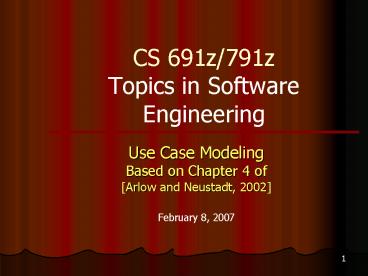CS 691z/791z Topics in Software Engineering - PowerPoint PPT Presentation
Title:
CS 691z/791z Topics in Software Engineering
Description:
The use case diagram shows the system boundary, the use cases internal to the ... Synchronization between the project glossary and the UML model is needed. 11 ... – PowerPoint PPT presentation
Number of Views:30
Avg rating:3.0/5.0
Title: CS 691z/791z Topics in Software Engineering
1
CS 691z/791zTopics in Software Engineering
- Use Case Modeling
- Based on Chapter 4 of
- Arlow and Neustadt, 2002
- February 8, 2007
2
Outline
- Use case modeling
- Overview
- Finding actors and use cases
- Detailing use cases
- Scenarios
3
Use Case Modeling Overview
- The Use Case Model consists of the following
- Actors
- Use cases
- Relationships
- System boundary
- Steps of use case modeling
- Find the system boundary
- Find the actors
- Find the use cases
- Specify the use cases
- Create scenarios
4
Finding Actors and Use Cases
- Fig. 4.2 Arlow Neustadt 2002
5
.Finding Actors and Use Cases..
- An actor is a role taken by an external entity
when interacting with the system directly - An actor is a stereotype of class with its own
icon - Fig. 4.3 and 4.4 Arlow Neustadt 2002
6
..Finding Actors and Use Cases.
- An actor
- Is always external to the system
- Interacts directly with the system
- Represents a role played by people or things, not
specific people or specific things - According to Rumbaugh, a use case is a
specification of sequences of actions, including
variant sequences and error sequences, that a
system, subsystem, or class can perform by
interacting with outside actors - Use cases
- Are always started by an actor
- Are always written from an actors point of view
7
Finding Actors and Use Cases
- Examples of use cases, Fig. 4.5 Arlow Neustadt
2002 - Names of use cases should be verb phrases
- Candidate use cases can be discovered starting
from the list of actors (how they interact with
the system?) - Finding use cases is an iterative process
8
.Finding Actors and Use Cases..
- Questions you can ask to identify use cases
- What functions a specific actor wants from the
system? - Does the system store and retrieve information?
If yes, which actors are involved? - Are any actors notified when the system changes
its state? - Are any external events that affect the system?
What notifies the system about these events?
9
..Finding Actors and Use Cases.
- The use case diagram shows the system boundary,
the use cases internal to the system, and the
actors external to the system, e.g. Fig.4.6,
Arlow and Neustadt 2002
10
Finding Actors and Use Cases
- The project glossary
- Important project artifact
- Provides a dictionary of key business terms
- Captures business language and jargon
- Should resolve synonyms and homonyms
- Should be understandable by all stakeholders
- UML does not set a standard for the project
glossary - Synchronization between the project glossary and
the UML model is needed
11
Detailing Use Cases..
- The output of this activity is a more detailed
use case that consists at least of the use case
name and use case specification. - Most common template for use case specification,
Fig. 4.8 Arlow Neustadt 2002
12
.Detailing Use Cases.
- Branching, repetition, and alternative flows are
possible in a use case - Example of branching using the keyword IF, Fig.
4.9 Arlow and Neustadt 2002
13
..Detailing Use Cases
- Example of alternative flows, Fig. 4.10 Arlow
and Neustadt 2002
14
Detailing Use Cases..
- Example of repetition within a flow (FOR), Fig.
4.11 Arlow and Neustadt 2002
15
.Detailing Use Cases.
- Example of repetition within a flow (WHILE), Fig.
4.12 Arlow and Neustadt 2002
16
..Detailing Use Cases
- Tracing requirements Table 4.I Arlow and
Neustadt, 2002
17
Scenarios.
- Primary scenario of a use case, Fig. 4.13 Arlow
and Neustadt, 2002
18
.Scenarios
- Secondary scenario of a use case, Fig. 4.14
Arlow and Neustadt, 2001































